
Table of contents
-
Awareness
- Define your target group
- Pick key promotional activities
- Choose communication channels
- Set your tone
- Measure your efforts
- Expert: Awareness
-
Acquisition
- Master the content marketing
- Don’t forget webinars, conferences, workshops
- Try paid acquisition
- Seek affiliates
- Get creative
- Expert: Acquisition
-
Engagement
- Perform live demos
- Set onsite CTAs
- Provide educational cycles
- Try again with remarketing
- Measure and optimise
- Expert: Engagement
-
Sales
- Bet on social proof
- Optimise sales forms
- Never accept abandoned carts
- Let them try before they buy
- Proactively help using the product
- Expert: Sales
-
Retention
- Embrace your clients
- Reward loyalty
- Track their preferences
- Be there for them
- Show the backstage
- Expert: Retention
Focus on the customer
25 key tactics for customer lifecycle marketing
Why building client relationships is so important to your business
You’ve probably asked yourself more than once – what makes people choose specific brands? It’s the comforting stability that goes with routine, sure, but marketing research shows there’s more to that. We stick to our picks because of the whole lot the companies do to persuade us – from strategic marketing to customer service and CSR.
If you are one of these companies, it’s quite possible you’ve tried walking in your client’s shoes on the “customer journey” or pushed your audience/leads/customers through the magic sales funnel. All these AIDA/journey/funnel techniques are being exploited by companies all over the world but do marketers and salespeople ask themselves what’s next? What’s at the end of the client’s journey? Forget about this client and try to hook another one? After all, you’ve been through?
The examples of cutting-edge brands show that it’s all about building long-term relationships. In simple words, the trick is not only to meet new people but to keep them as friends. Nothing new here. You’ve also probably heard already that you need to show your human-self as a brand to acquire customers’ trust. Provide such an experience for your potential client that they will not only purchase but come back again and again.
To put words into actions and meet your business objectives, you should create a very detailed strategy. Make sure you focus on the customer at each stage of the lifecycle:
- Define the right audience (AWARENESS)
- Grab their attention (ACQUISITION)
- Get to know each other better (ENGAGEMENT)
- Provide the best shopping experience (SALES)
- Show that you are thankful and trustworthy (RETENTION)
- Repeat!
Therefore, if you provide all actions that help you find new clients and look after them simultaneously, your company’s growth will spiral.
In this guide, you will read about the practical approach to customer lifecycle marketing. You will learn key tactics and get the experts’ advice on how to:
- Consider the entire journey strategically.
- Measure your performance.
- Approach customers at each stage of the cycle.
- Build your experience in handling leads and clients.
- Optimise your ROI through the joint efforts of the entire company.
Chapter 1 Awareness
81% of buyers are more likely to engage with a strong, professional brand.
[Source]
There are many different ways that your customers can take to get to you. The progress of your relationship is rarely linear, as we’ve already mentioned. There is a cycle that’s spinning like a carousel and as a brand, you should make it as easy as possible for your potential clients to hop on. Be prepared for lots of scenarios. Remember that it’s more likely for them to join the ride if their friends are already there. No matter how big your company is, you should always pay attention to maintaining brand awareness within your industry because, well, you never know.
In the perfect world, however, everything starts with the first look. Your customer needs to get to know you, be aware that you are on the market, what you have to offer, and most of all – what kind of person you are. Yes, person. If you think of acquiring new loyal customers as building relationships, you should show a human side to your brand. It’s been said a lot lately in the marketing world but studies confirm that theory. Obviously, you don’t have to let your community managers post their selfies and brain dumps into your social media channels.
It’s more about creating a Brand Personality – a collective mindset for the whole company. A set of visual and communication guidelines so that you keep the consistent image that your audience may relate to and create a bond with. Its values and tone of voice need to resonate with your audience. So first things first. You need to do the proper research and reach out to the right people in the right way.
Your tone of voice needs to resonate with your audience so do the proper research.
We’ve gathered a few tactics that successful brands perform to achieve the most profitable results. Although, you should remember that this is just the first stage. Don’t you rush your relationships. Give your audience space to create a bond. Take your time doing research and planning strategically or all your efforts will go to waste.
1. Define your target group
Learn as much as you can about your audience to optimise your communication. Discover averaged demographic data (like age, gender, location, income) using dedicated tools like SentiOne.
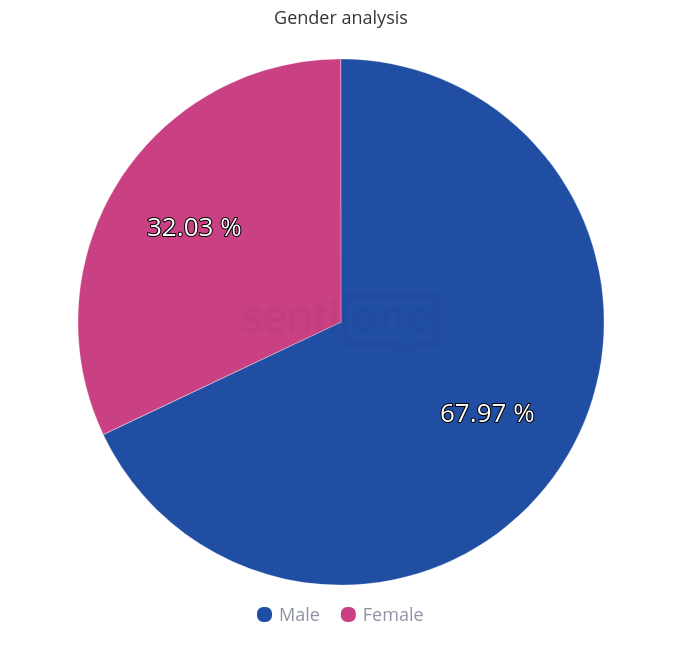
Besides, try to define much deeper insights like lifestyle preferences, personality, attitudes, challenges, needs, values, habits and online behaviour. To do so, you will need to find your model customers or users and interview them to draw data-driven conclusions.
You can also check what your competitors have done already. Use tools like SemRush or SimilarWeb to find competitor offers online or simply check their website and owned media.
Find any other market research that can help you discover general trends in your industry. Google the key search trends (Google Keyword Planner, Google Trends) and make sure you never miss out on anything with Statista.com, Nielsen, or eMarketer.
2. Pick key promotional activities
When planning awareness campaigns, you really need to focus on brand image and reach. Remember that people trust each other more than direct brand message. References work like a charm, especially in B2B sector. You might want to reach out for the the support – of influencers, other brands, your users.
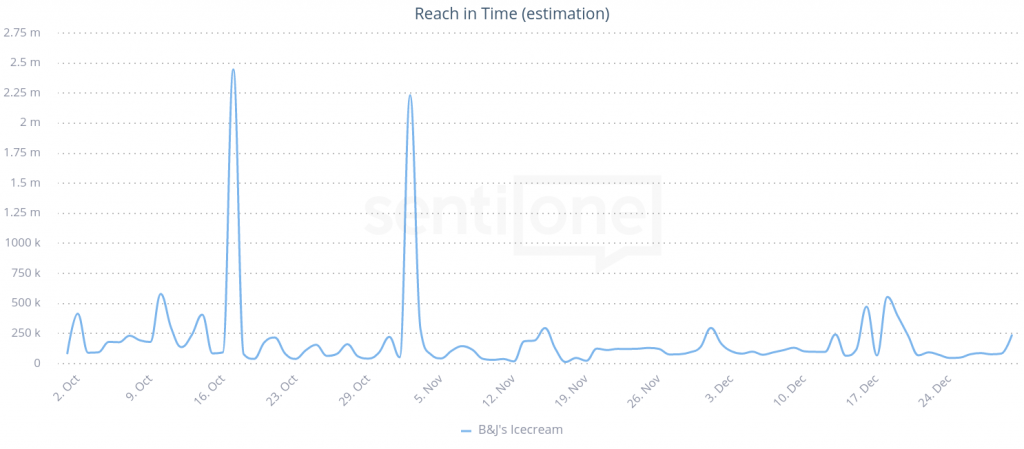
Here are the top channels and activities that we’ve found most effective for building brand awareness as a SaaS:
- social media (Facebook, Twitter, LinkedIn) both paid and organic,
- online and offline sponsorships,
- influencer marketing,
- review and comparison sites,
- co-marketing and guest posting.
3. Choose communication channels
Not all channels are suitable for building awareness. It may seem that if you are super active, you may get more leads. The thing is, however, you wouldn’t want to overwhelm your audience or blow your budget. Make sure you match your message to the specific target group and media. Find out on which social media your potential clients are most active. You can do this using online listening tools like SentiOne and its widgets displaying sources of mentions breakdown.
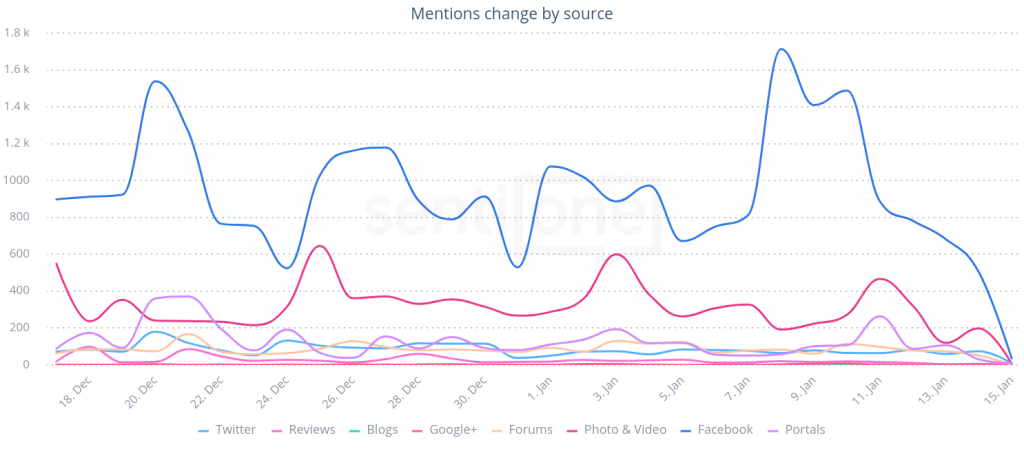
4. Set your tone
You know already know who you are talking to, what are you going to say and where. All you need to do now, is to decide how to say it. Try social listening to track social media conversations that are happening around the area of your interest. This way you can get not only social media data analysis but also qualitative research regarding your audience’s lingo, interests and values.
It is the key strategic point to be authentic and build a true relationship. Think of your Brand Personality – whether you want it to be more straightforward or formal, what kind of language do you want to use on each channel of communication. Write it down and make sure you update this document along with the growth of your brand.
If you have the rules set already, make sure you keep the consistency within your Marketing, PR, Client Service, and Sales Teams. They all need to be on the same page when it comes to speaking the brand’s voice.
5. Measure your efforts
Brand awareness campaigns don’t have a direct impact on sales so it’s a bit tricky to measure their effectiveness. They focus rather on long-term goals. There are, however, some accurate indicators that can help you find out if you are on the right track.
To learn how your brand is expanding, make sure you cover:
- Organic search (Google Search Console)
- Organic traffic to your website and sources (Analytics)
- Engagement on your online channels
- Reviews and opinions about your brand
- Sentiment surrounding your brand
- Brand mentions growth across the web

Jamie Turner says:
I’ve been very fortunate over the course of my career to be able to help some of the world’s greatest brands build awareness and create demand for their products and services. Some of these brands are very well known around the globe, such as Coca-Cola, CNN, and Holiday Inn. Other brands are smaller and less well known, such as Maid Brigade and Carolina One Real Estate.
But no matter how big or small the organization, they all had one thing in common – they all needed to build awareness of their products or services so that they could create demand. Without awareness, there is no demand. And without demand, there is no revenue. So, as you can see, it’s extremely important to build awareness for your brand, no matter how large or small.
All this raises the question, “What’s the best way to build awareness for my brand?” Before we answer that question, let’s take a look at the sales funnel and how it actually works (instead of how most people think it works).
On the left hand side of the image below, you see the standard sales funnel that assumes your prospect starts at the top with Awareness and moves through six different stages before they end up at the bottom with a Purchase. This is a good explanation of the theoretical journey a customer makes when they engage with your brand and then make a purchase.
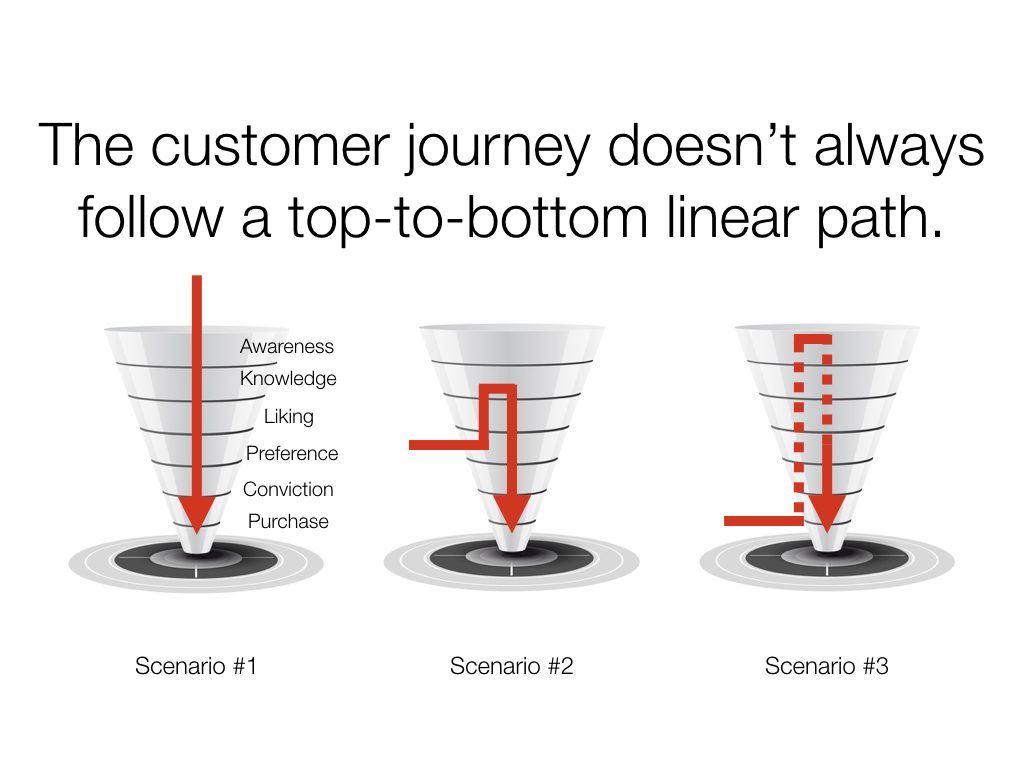
But the real world doesn’t work that way. As we all know, sometimes consumers will start in the middle of a sales funnel, move up a few steps, then move down to the bottom, as seen in scenario #2. Other times, consumers will start at the bottom of the sales funnel, skip up to the top, then pick up in the middle before moving back to the bottom, as seen in scenario #3.
These are just 3 of the nearly infinite number of ways a consumer can move through the sales funnel.
So, given all that, what’s a marketer to do? What many major brands are doing to address this reality is something called Nonlinear Marketing, which builds awareness for a product or service in a multitude of traditional and nontraditional ways.
Nonlinear Marketing is a strategic approach that is different from traditional, linear marketing. In the past, with traditional marketing, organizations would interrupt a consumer’s life with a sales pitch, often delivered via a TV, radio, or print ad. The goal was to pound the sales message into the mind of the consumer so frequently that they eventually gave in and bought the product.
The problem is that that technique no longer works. Consumers resist persistent sales messages and are now using ad blockers and other techniques to prevent marketers from getting through.
The solution, whether you’re trying to build initial awareness or convert a prospect into a customer, is to use Nonlinear Marketing to weave your brand into the fabric of the consumer’s life.
What does that mean? It means that you shift your brand from being a sales-oriented brand to being a helping-oriented brand. Instead of interrupting the consumer’s life with a sales message, you become part of their life with messages that help them fulfil their greatest aspirations.
Whether you realize it or not, you’ve probably experienced Nonlinear Marketing campaigns already. The last time you read a sponsored post on Facebook, watched a branded YouTube video, attended a sponsored event, filled out a branded survey, or engaged with a brand via Twitter, you might have been experiencing a Nonlinear Marketing campaign.
As an example, when Red Bull creates the Red Bull air races to provide an aspirational experience for its prospects and customers, they’re taking a Nonlinear Marketing approach. When Starbucks creates their web series called Upstanders to promote ordinary people who do good in the world, they’re taking a Nonlinear Marketing approach. Or when Google provides free online training for their products and services as a way to deepen their relationship with their customers, they’re taking a Nonlinear Marketing approach.
All that said, is running a Nonlinear Marketing campaign as simple as running a few marketing tactics? No, not really. That’s because Nonlinear Marketing is a strategy, not a tactic. In other words, it’s a way of re-examining how your brand engages with prospects, builds awareness with them, and ultimately converts them into customers.
One of the easiest ways to wrap your mind around Nonlinear Marketing is to think of it not as a sales funnel, but as a sales web. In other words, instead of managing a prospect’s behavior from the top of the sales funnel to the bottom of the sales funnel, you’re creating an invisible web that captures them, much the way a spider’s web captures insects.
Take a look at the graphic below which provides insights about Nonlinear Marketing is a quick, easy-to-read chart.

All this begs the question, “How can I use Nonlinear Marketing to build awareness for my product or service?” The answer is to first understand that shifting to a Nonlinear Marketing strategy is an evolution, not a revolution. In other words, you don’t want to go into your office and throw everything away. Instead, you want to ask some simple questions:
- Is this campaign helping my prospects or selling them? (A Nonlinear Marketing campaign is a helping campaign, not a selling one.)
- Is this campaign designed to weave our brand into the everyday life of my consumer?
- Is this campaign building awareness for my brand by engaging with them across a wide variety of platforms?
That last bullet point is an important one because the idea behind Nonlinear Marketing isn’t to throw away traditional marketing platforms. In fact, traditional marketing platforms like TV, radio, and print are perfectly good at delivering on the Nonlinear Marketing promise. The key is to use both traditional and contemporary platforms to engage your prospect in experiential, involving, helping campaigns that provide a deeper, more meaningful relationship between the brand and the consumer.
One final point. Remember, it’s one thing to understand a concept intellectually. It’s another thing to take action on a concept. So as you read through this ebook, ask yourself how you’re going to apply what you’re learning to your next campaign. By doing so, you’ll be able to see the positive results for your organization grow over time.
Chapter 2 Acquisition
Content marketing costs 62% less than traditional marketing and generates about 3 times as many leads.
[Source]
It’s not easy to draw a fine line between the stages of the customer lifecycle. The important thing to remember – as said above – is to keep performing different campaigns at the same time. Because you never know when your audience is ready for the next step. Keep trying before you get exclusive.
If you think of building client relationships as dating, acquisition stage would be like getting the person’s number. You’ve seen each other before, maybe you’ve impressed them with a nice picture on Instagram or maybe they’ve seen your band’s show. That would be awareness, as in they’re aware of your existence and think of you quite well because you perform at the right time, in most fashionable spots, and for the mighty fine audience. Now is the time for the direct approach.
In the marketing world, it means reaching out to the precise target group. With the proper message. Match your content and put a lot of effort for it to be attractive because at the end of the day you need to acquire leads (the person’s number). And when you do, don’t lose them. Make sure you use a proper sales CRM system (like Close.io for example).
Obviously, not all the people who acknowledge your company’s offer will give you their email or purchase at some point. This is where the idea of funnel makes sense – to imagine the proportions of your audiences on each stage. So the main difference between awareness campaigns and acquisition activities is that you optimise the later strictly for conversions. To get in touch with the people who are more likely to buy your product. While creating, for example, landing pages or PPC campaigns always remember the bottom line is to hook your audience’s attention. Make them curious enough that they will want to give you their contact.
There are a lot of different ways of generating leads. From our experience, regardless of which lead generating tactics you use, there are three key focus points that are common to all of them:
- Make it pretty. The visual side of your content (whether it’s a blog article or your conference presentation) should be esthetical and attention-grabbing.
- Make it foolproof. Make sure your assets are optimised UX-wise. Don’t lose your audience’s focus. Their attention span is quite short.
- Give them the beef. What you say, needs to resonate with your target so make sure your content has a pro quality to it and comes with an actual value.
1. Master the content marketing
If I said “Content is king” would you stop reading now, leave and never come back? I know you’ve probably heard it a bazillion times but big brands’ examples show that it is true. Well, the hype maybe oversold it a bit but if you do it right, it will pay off eventually. If it’s planned strategically, well-prepared, and revenue-oriented.
Even though the direct outcome of content may seem as not very tangible, marketers around the world can’t be wrong, right? The trick is to find the difference between just having a blog and providing quality content that your audience will find attractive. Don’t overthink it, though. Simply, find your niche, a story to tell, make sure you know what you’re doing – prepare specific pieces of content for each stage of your buyer’s journey. And learn how to measure it.
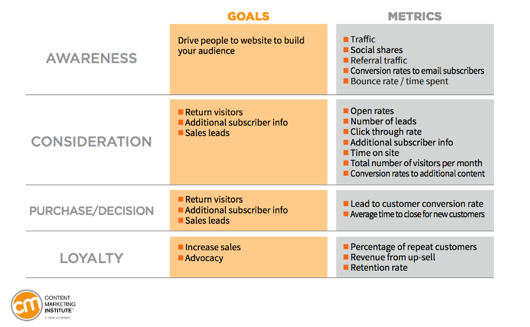
The idea of giving your audience a targeted content, that is professional and valuable, is based on the whole lifecycle strategics. It helps to build a relationship. If you provide your audience with nice case studies, ebooks, guides, videos, chocolates and flowers they will love you. In fact, give them so much quality content that they will feel embarrassed. Propose free tips in the form of a newsletter. It’s a psychology trick to make them want to repay somehow like at least leave you their email address.
2. Don’t forget webinars, conferences, workshops
You will say video, presentations, and decks are content, right? But it’s quite specific and en vogue too so we wanted to give it a very special spot here. This versatile tactic work to your advantage on many different levels. It gives you recognition and authority as well. But most of all it’s one of the most direct approaches to growth hacking.
You will never find a more convincing way that there are people behind your product than showing an actual human being talking on behalf of your brand. And it’s not about who’s the prom queen of your industry but more like building a true connection with your audience. A community that you are willing to nurture.
Focus on your potential clients’ needs and try your best to address them. This way they will see that you are ready to go out of your comfort zone to share your knowledge. And that their well-being is your priority.
Although it may sound a bit hippie, it’s truly not “making the world a better place”, no. You may want to solve your potential client’s issues but remember why you are doing it. A satisfied client will bring revenue to your company. So try not to forget about the measurements for your video or live speeches. However warm and cosy you may feel in the flashlights, stay focused on your brand. The key here is to find the balance between being nice and professional.
3. Try paid acquisition
A good old ad never killed nobody. You may think you’re better than this, that there’s hardly any space to stand out, or – on the contrary – that you just throw some money and the traffic will grow like magic beans. Well, consider this – the key to a good paid acquisition campaign is optimisation. Because people are different and like different things.
Iterative work, deductive reasoning, killing off the bad creations and setting up new ones. The world changes fast; people get bored pretty easily these days. What worked for you just fine in the last quarter might as well go to garbage next month. And you’ve got to stay chill as a cucumber. Because the silver lining here is the chances that you will blow your money with that approach are way lower because you simply adjust to the market needs.
So before you give up your hopes or get too excited over PPC, do your research. It’s not about whether you like it. All your ads should be customer-oriented! Check benchmarks, gather keywords, think of your Brand Personality, and prepare as many versions as you can. Set it free and watch it fly. Don’t hesitate to pivot with your ideas. And finally, try different channels, like:
- Adwords and Display,
- Social media paid promotions and ads (Facebook and Instagram are very welcoming),
- Search Engine Marketing.
4. Seek affiliates
“No man is an island” as John Donne said. So is your brand. Whatever you do, think of the impact you want it to have on your audience. And now think how much more impact it will have when you are supported by influencers or friendly brands. Benefit from the synergy you create while working with others.
What types of affiliate initiatives there are?
- Loyalty programs on websites that gather multiple brands and provide conjoined sales offers.
- Email marketing lists that share communication from numerous brands.
- Affiliate networks, influencer agencies and platforms like i.e. Digidip.
When trying affiliates, make sure you are ready to track it. Use UTM code tracking to make sure you know where the traffic comes from. There are a lot of other obstacles like unverified rebate platforms or fake influencers. (Read more on how to recognise fake influencers and other online malicious behaviours.) Stay safe because when you cooperate you may be vulnerable. Always choose wisely the person with whom you want to create greater things.
5. Get creative
There are like billions of terms in marketing. The customer lifecycle marketing, for example, is a part of what’s been called non-linear marketing. There’s online marketing, digital marketing, social media marketing, and probably a dozen other names for what people do on the web to sell their product. Marketers bend over backwards to acquire consumers. And still, after all these years, there’s still a lot of space in guerilla marketing, or to put it simply – being creative.
With online, social media came up to be perfect land for unconventional campaigns. A lot of brands now choose to create hashtags and challenges promoting their campaigns. Take for instance the famous Ice Bucket Challenge led by ALS organisations, including ALS Association in the USA. The challenge was aimed to promote the awareness of the amyotrophic lateral sclerosis disease and research for the cure. It first spread in summer 2014 and has been repeating since then. This viral initiative involved putting a video on social media of being poured with ice-cold water and donating to ALS research. It reached almost 2.5 million tagged videos posted on Facebook.
The success of this campaign – according to top experts – indicates that the audiences are not afraid to take the challenge; we are social after all. It was based on competitiveness, social media pressure, low barriers to entry, and a good cause behind all that. It was destined for success. And as a creative, you need to learn that lesson and never be afraid to try your own brand new innovative methods for acquiring leads.
Dave Chaffey says:
Do you know the saying: “If you build it, they (he) will come”? If you do, you’ll know it’s what Kevin Costner’s character said in Field of Dreams. It’s a classic 1989 American fantasy film about building a Baseball stadium to attract fans in rural Iowa. Way back then, we were building up to the ‘dot.com bubble’ and this saying was often applied to websites. Although the fantasy came true in Hollywood style, in the real world it’s far harder. Even the best-designed sites will fail if there isn’t a proactive promotion or a powerful, engaging brand is created to attract visits.
Today, to use digital marketing for acquisition we’re in a great position since we know that if we get it right, we can harness the power of inbound and content marketing to get the results we need. But still, it’s not easy since the power of techniques like search, content marketing and social media marketing are so well known that whichever sector you are in, it’s competitive.
In my experience, there are some fundamentals you need in place to create a solid acquisition strategy. This is what I have learned from working as a consultant with many companies in different sectors and in building SmartInsights.com to a site with a reach of ½ million uniques each month that is used by marketers in other 100 different countries.
Be realistic. Forecast what you can really deliver.
We’re fortunate to have great insight on how our audiences use search, social media and publisher sites. But many marketers don’t harness this to build realistic models of how many they can attract to their site or stores using inbound marketing. Different channels vary dramatically in their ability to engage audiences and get responses. I recommend building spreadsheet based conversion models so that you don’t overpromise and under-deliver.
Know your audience
There is a tendency to start with your media options when planning your acquisition. But, starting with your audience will always pay dividends since there are so many options today to use media to attract interest from specific types of people who are most likely to be interested in your products and services. These include content marketing where we can map content themes to audience interest and paid media targeting where we can use demographic targeting for prospecting across publisher sites and social networks.
Be ruthless on prioritising on media
If you drill down to all the media options available across search, social networks, email and publishing, there are so many options. We identified over 100 including existing channels. To help you prioritise I recommend using the Marketing Bullseye to identify priorities for investment in online acquisition. It really helps you focus at the top level what will give you acquisition traction whether you’re a startup reviewing your options or an established company reviewing your acquisition strategy.
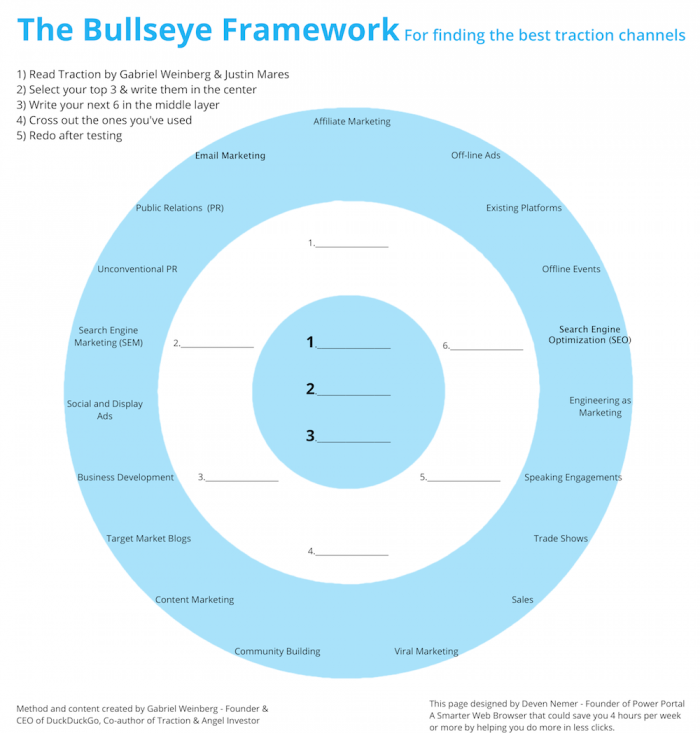
Don’t forget to work on integration across the lifecycle
With digital media and traditional media it’s all too easy to forget about integration. But we all know the theory of Integrated Marketing Communications (IMC). If you can remind people about a proposition or deal across multiple channels in an engaging, consistent way you will have a higher impact response. I recommend reviewing all the touchpoints across the customer lifecycle and then ensuring you’re balancing paid vs owned vs owned media to get the maximum impact. Although inbound marketing is often thought of as being based around content marketing, using paid media or email to retarget people you have already engaged is essential to boost overall response.
Learn from what works for others
If you look at websites from a single sector, you will notice that often they have similar design styles and messaging because competitors review what each other are doing. Its less easy, but you should also use insights tools and services to see which marketing techniques are working for your competitors. You can see which content and search terms are most popular, how different audiences respond and which content is shared.
Be creative, have personality
With this natural tendency to copy, getting cut-through and differentiating yourself can be difficult. This can often be an issue for established brands since they don’t have the personality to become memorable. To get engagement through digital media and particularly social media a personality is paramount. Take a look at Personality Not Included by Rohit Bharvaga to get ideas on how to review and improve brand personality.
Be agile, be responsive
To stay engaging and relevant there are frequent opportunities to use the real-time nature of news and social media to have an opinion and engage your audience about the current zeitgeist. So, you need to build in flexibility into your processes so you can harness these. An editorial plan is still useful to give a structure to themes to engage different audiences, but there should be flexibility for you to ‘newsjack’ where your monitoring shows there is a good scope to engage your audience.
Get serious about measurement
This links back to our first point. Your forecast should define cost-per-acquisition limits based on the cost-per-click and conversion from different media. Your tracking should assess these and you should put in place the measurement KPIs and campaign media tracking so that you can see which media are working and which aren’t and then iterate.
So, this is what I have learned. I’m sure many of these themes resonate with you. To bring them all together, I believe it’s essential to have a planned approach that is appropriate to your type of business. If you work for a small business then having an acquisition plan is still important since otherwise you will probably try to do too much rather than focusing on what really matters to you. In a larger business, the need for an acquisition plan is clearer since you need to communicate your approach internally and make the case for the returns you are looking for from your investment.
Chapter 3 Engagement
95% of the visitors don’t share their email addresses, which means marketers must find new ways of reaching and nurturing this anonymous but valuable audience.
[Source]
Once your potential client familiarised himself with your brand, and you’ve made the first contact, you need to point his attention to the product. However…
Above all, you need to remember not to talk about the product itself!
It’s like offering a magnificent boeuf bourguignon that you’ve just put out of the oven to a kid at the top of its tantrum. The customer doesn’t want to hear about you and your silly product. We live in the world of advertisements so people are truly overwhelmed with all the things they need to have, like, *right now*. It is getting really confusing.
Only empathy will save you here. Your main focus should be to define pain points of your buyer persona and how to address them.
Listen to the voice of the customer, learn his needs, and show how your product is the cure to all evil. Name the kids needs, say it’s hungry and you know how it feels because you’ve been hungry before and that’s partly why you started the company in the first place (Note: a good story sells like a charm!). Tell how you think this tasty beef will fill him with warmth, joy, and cosiness (benefits!). And how it’s right there, at his fingertips, and he even can try for free!
Well, I guess we went a bit too far with the kid metaphor, didn’t we? Anyway, make sure that to engage your customers, you need to empathise with them. Learn their needs, define them and find the tactics to always be ready to swoop in armed with benefits that come with your product.
1. Perform live demos
You may elaborate on how your product will save lives of your potential clients, sure. And it’s very important that you do. First of all, written communication can be consumed anytime. Second, it’s easy to find specific information in writing. It works good for SEO, too.
But there’s nothing more convincing than showing exactly how it works. How you do it. Direct contact helps to build relationships, your clients will get involved in your presentation, can ask questions, and refer to the specific issues they want to address with the product or service you are providing. Simply prepare the basic tutorial and show it to the world.
What types of demos can you try?
- Personal meeting with your potential client,
- A call or video chat with your lead,
- Live video tutorials in a form of webinars – best with a sign-in, thanks to which you can collect emails,
- Recorded video tutorials – shown on on-site chat, mailings, social media,
- Use cases on the website – show what types of issues in which industries can be solved with your product – it’s best if you match it to your Buyer Personas’ needs.
2. Set onsite CTAs
Remember that all of your online communication should lead to one action you want your readers to accomplish in the end. May it be a sign-in for your webinar, downloading an ebook, starting a free trial, booking a demo, or buying now. A person needs to know what to do. The real purpose of the page.
The first rule of website optimisation is to decide what do you want to bring about and say it loud and clear.
There is a number of tools that can help you achieve deeper on-site engagement i.e. CTA buttons, exit pop-ups, surveys etc. Use i.e. Omniconvert or SurveyGizmo to provide the most effective widgets.
For starters, you can try some expert’s advice on CTAs like:
- Make sure that your button is visible.
- Try a contrasting colour.
- With copy, go straight to the point and use a simple verb (explicitly say: SIGN IN, DOWNLOAD, START).
- Use 1 to 5 words.
- Use “power words”, as in the vocabulary that may encourage the quick action even more, like NOW, FREE, INSTANT.
- Place your button in different locations – remember that some people may have the so-called “banner blindness” and their sight will subconsciously skip your message.
- Test and optimise – try different colours and copy depending on your audience and other circumstances.
3. Provide educational cycles
In a perfect world, your product is exactly what the masses are looking for and and you just give them a shout and sell like crazy. Let’s face it, it’s barely ever like that. We can’t stress that enough that you need to focus a whole lot of activities on very specific target groups. Discover the basic truths and values of your audience and find the benefits your product will give them.
Sometimes they don’t even realise that your product will save their lives. In that case, the first step will be to create a need. To do so, you need to educate, educate, and then educate some more. And even if you are already a strong brand, never forget that there are people out there who would use this specific knowledge.
Using different media and types of content (like webinars, landing pages, use cases, ads, emails, blog articles) you can provide professional advice. And it will be surely more digestible and engaging if you slice the knowledge and give it part after part in a form of some series or cycles.
4. Try again with remarketing
Not everybody falls in love at first sight. So make sure you give your audience a second chance to love you. There are many tools that help with retargeting campaigns. You can start with Google ads which provide special settings and features thanks to which you can reach people who have been to your website before.
Try these retargeting paths tested by SaaS marketers:
- If you have traffic on your content landing pages (like whitepapers, ebooks, online guides) from social media, ads or search and want them to leave emails to become leads and eventually sign up for trial.
- If you have traffic on your homepage from social media, ads or search and want them to sign up for trial and eventually buy your product online.
A good practice is to display your ads for a few days right after the customer visited your site, give them a little break, and then try again after a few weeks. Remember that you want to poke them gently to remind what benefits come with your product and not overwhelm with your banners all over the internet. Be gentle and patient.
5. Measure and optimise
This is where you can become a fully legal hacker. Growth hacker. First, get the pro tips to growth hacking. And then use your freshly learnt knowledge to polish your skills.
Tl;dr for you:
- Love the data – when growing your traffic, conversions, customer base, make sure you get benchmarks. Always measure and make a habit out of summarising and comparing the data. Use tools like HotJar, Usabilla, Google Analytics, Mixpanel, Kissmetrics for more precise qualitative data and automation.
- Question the metrics – As much as you need to pay attention to data, don’t let it cloud your judgement. Always leave a margin for error, don’t fall for causation-correlation bias, and thinks outside of the box (sometimes your data may differ because of the most unexpected reasons like the weather outside).
- Test and rewrite – Trust your instincts. But not all the way. Make rather data-driven decisions. Perform A/B tests and run multiple campaigns to make sure you cover all the possible theories.
- Appreciate the feedback – Whether it’s a survey or complaint, direct or written on social media, consider all the information you can get. Use social listening to track all opinions about your brand and get the most honest and unbiased opinions.
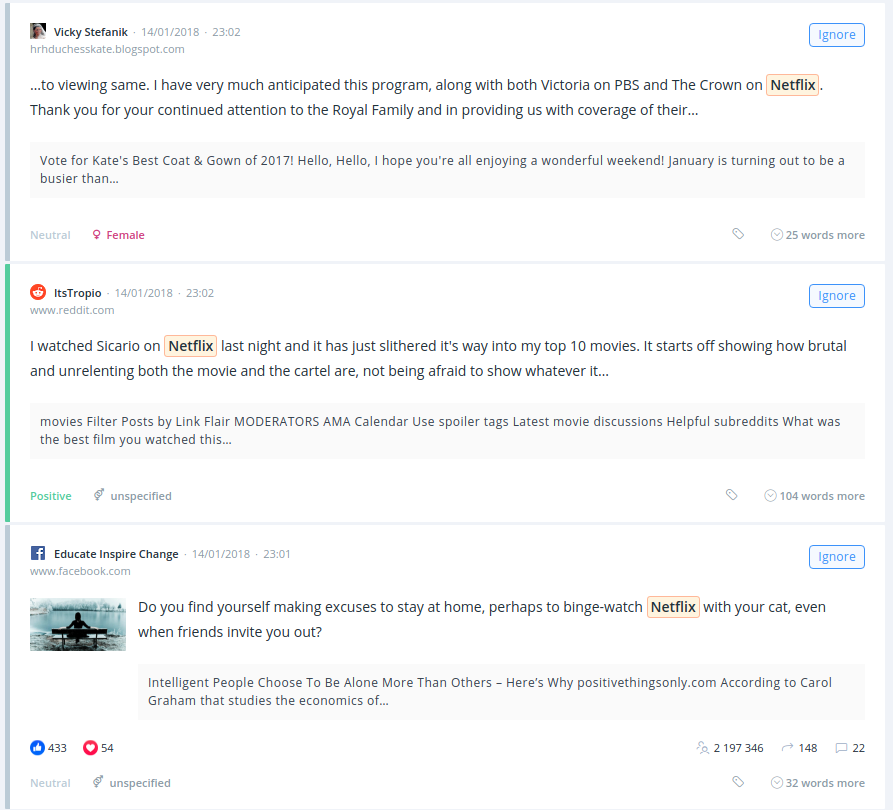
Valentin Radu says:
If you want to engage your visitors better, the first thing that you want to do is to understand what their main pain point is. In this game of global economics, the company that wins and stays ahead of its competitors is not the one that states things about what they do or what their solution is, but the one that empathizes the most with the customers and defines their problem the best. In this manner, their visitors will automatically associate them also with the solution they seek.
The first step to discover the buyer personas and investigate their business needs is to understand the phase they are currently in: is he in the awareness phase, the consideration phase or it is he ready to place the order?
Basically, in this step, you find out who is on your website, how many visitors are looking to get more information, how many of the visitors are aware of their problem, how many of them are searching for a solution via customer support.
Give your visitors a voice and engage with them to understand their behavior. You can easily do this using on-site surveys.
The most important surveys you can run to understand visitors better will give the answer to what they are looking for: how many of them found what they were searching, how many of them are looking for customer support or any other relevant things.
After running this type of survey, you should investigate more details about them: what is their role and what best describes them. Discover this important information by asking the right question. For example, if you are selling a project management solution, ask about the reason behind the purchase: are they looking for a time management solution, tracking the time, ways to be more efficient or ways to get everyone on the same page in their team.
Once you know the buyer personas, the next step on the list is to start optimizing the journey of the visitors. You can build up a lead generation strategy, treat the customer’s objections in real time with surveys, display personalized messages and test different versions of your website. You can easily optimize all the above with Omniconvert.
Asking visitors about their needs will make them feel appreciated. Do not ask them about the sales process, do not be intrusive and pushy trying to sell them a specific product. Investigate their needs and ask the questions that will provide relevant information about your buyer persona.
Not convinced yet about the power of surveys with objection treatment personalizations? Here is an example that brought GetMaine Lobster, an American online retailer, a 51% conversion rate uplift. All the details about this are in this case study.
Now that you have these details, make sure you display the solution for each buyer persona. Basically, my advice is to prepare the landing page according to the purpose of the visitors: for the ones looking for customer support, the ones that are selecting the solution or for the ones that are in the awareness phase.
Long story short: the content of the landing page is not about you, but about the visitor’s needs and desires. Don’t neglect this crucial aspect and you will see the improvements.
Another important thing when you craft the landing page is to consider the following constraints.
One of them is the fact that people are having an attention span of only 8 seconds and a goldfish has one of 9 seconds.
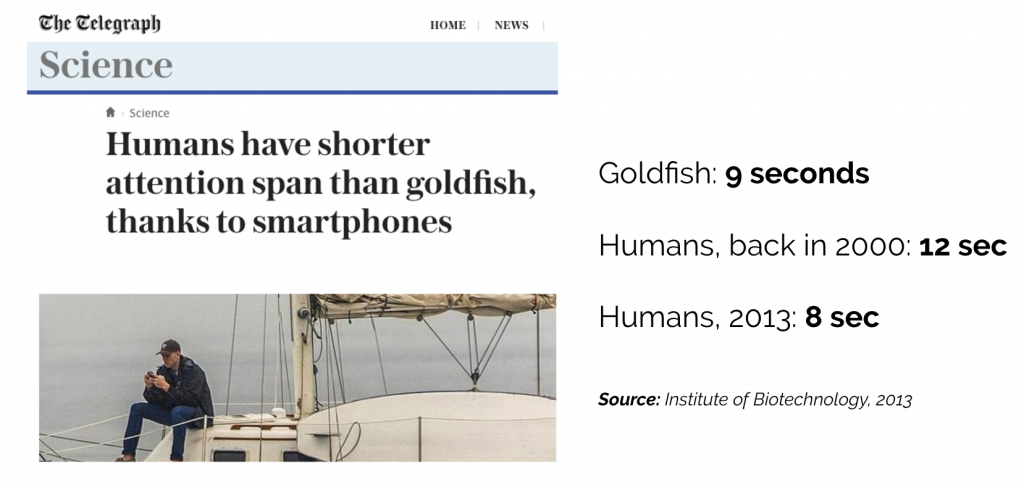
This means the attention span is decreasing so you have time constraints. There isn’t too much time to push all the data you want to the visitors. Focus on the first thing they see on the landing page: the unique value proposition. The UVP is one of the most important elements on the landing page because in less than 8 seconds your visitors will read it and make their next decision based on it. In those seconds, the visitor will decide whether your website is the right one for him or if he goes to another one.
After you prepare the landing page with the proper UVP and you craft the main message, the second constraint is about space. The eye’s retina allows any human being to see clearly only a rectangle of around 200 pixels, meaning that your visitor is not seeing clearly all the things you are pushing on the website.
Here is an example:
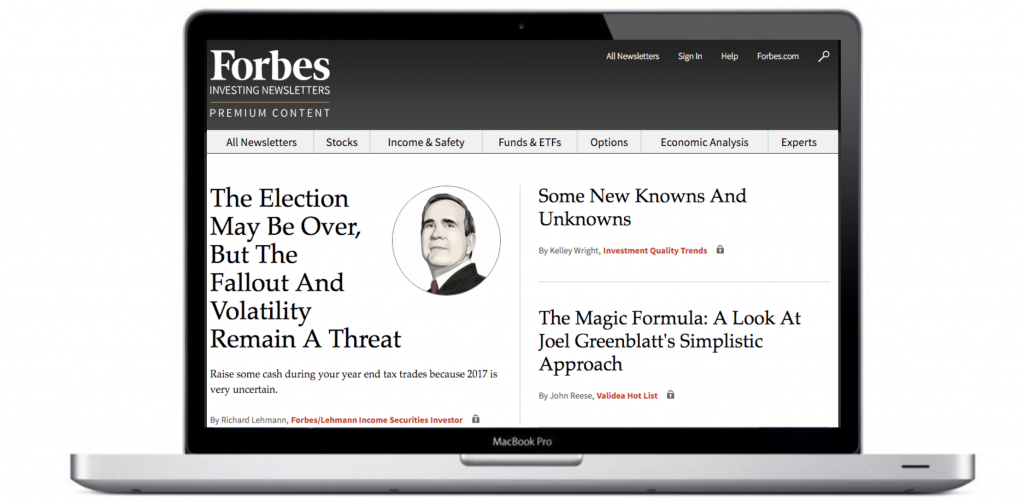

This is another reason why you shouldn’t push information noise.Build a clear, crisp message and make use of the white space: less is more.
Let’s recap what we have learnt so far. Discover the buyer personas using on-site surveys, treat their objections in real time and build the landing page according to their main pain point and who they are.
The next step is to analyze their on-site behavior: how many visitors are scrolling, clicking, and on what type of elements are the most used. All these actions will help you understand how effective your website is, and you can start doing A/B testing experiments to find out which UVP drives a higher engagement.
Also, another way to easily engage with your website’s visitors is to use personalization. For example, at Omniconvert we have a lot of data about the visitors: we know the traffic source, the content he read the last time he visited the website, new vs. returning visitor, etc.
Personalize the content of your website according to this type of data. Make use of the information you have about the visitor and segment the messages based on weather conditions, UTM parameters, IP, device type, cookie, name, customer lifetime value, geolocation and any other environmental details from the visitor’s background.
Doing so, you are relevant and you push supportive data to your audience. While using personalization, make sure you understand the need of the visitor and you emphasize his problem properly.
Here is how OLX used personalization to increase their app download rate by 60%.
Another important part of engaging with visitors is to take a deep dive into analytics. There are two types of data to measure the engagement: qualitative data (web surveys, heat maps) and quantitative data (session recordings, web analytics). Based on this data, come up with a hypothesis and then start testing and doing personalization experiments. What you need to understand is that visitor’s engagement with a website implies a certain behavior with a website. And, even though you cannot control the behavior of your website, you can control the dynamic content of your landing page.
To sum this up, engagement comes after you deliver value. So if the page is not delivering any value and not fulfilling the needs of your visitors the engagement will be very low. Focus on providing a relevant and personalizate on-site journey for all your visitors.
If you’re not already on the Omniconvert platform, NOW is one of the best times to join and start growing your online business the smart way.
Chapter 4 Sales
75% of customers say they use social media as part of the buying process
[Source]
Ultimately, all our efforts are made to drive sales. About 9 out of 10 startups don’t stand the test of time partly because they forget about that along the way. Winning the investor deal means so much that somehow they forget that at the end of the day the ultimate investor is the client.
The trick is to make the purchase experience as smooth as possible. You should ask yourself a question – why would you buy anything online? Because it’s quick, easy, effortless. You can subscribe to the online course, order a book or a vacuum cleaner, and also – get marketing automation tool. Regardless of what it is, when you go online to buy something, you simply want to save yourself the trouble of shopping. There are a lot of things we can do to simplify the process.
In this section, we will show you a few out of many online sales tactics that we find the most effective. It’s simple (however not easy). Not much has changed comparing to offline when it comes to customer’s behaviour. Mouth-to-mouth marketing is still the source of the most loyal clients. We believe the comfort of purchasing what you have already seen, as something that your peers have recommended, is the key here. For the customer lifecycle goes round and round, hopefully, marking a bigger circle each time.
1. Bet on social proof
It’s a winner. Psychology of marketing studied it thoroughly and it works wonders.
Social proof in marketing is how we like to but things that someone else already has. Preferably with the so-called halo effect, which means that we base our purchase decision on the general impression of the celebrity or expert. In our minds, if we buy something that a person we admire already has, we’d be a little bit like them.
It gives somewhat prestige and feeling of accomplishment. And decreases the FOMO, which in times of social media pressure is very comforting.
How to use social proof in online selling?
- Show your audience the testimonies of your other clients – the bigger fish, the better.
- Give case studies of how your clients made it thanks to your product.
- If you have an impressive number of followers or subscribers, don’t be shy – brag it!

- Try what we’ve already discussed – the support of influencers, experts, and celebrities.
- Encourage and gratify ratings, reviews, and recommendations on social media.
2. Optimise sales forms
There’s not much worse than non-friendly UI. We’ve all been there because, well, some people just can’t. It’s XXI century and some websites still look like the CEO’s nephew coded it as some kind of school project. You truly want to buy something and you pretty much hate yourself for that halfway through. Don’t be like them. Don’t hire your nephew. Unless he’s a world-class UX designer.
How to learn if your interface is user-friendly?
- Test it yourself. It’s a first, least costly step to wisdom, although might be a bit biased.
- Ask your friends and grandma to test it and write down their feedback.
- Interview a focus group, preferably matching your Buyer Personas.
- Watch heatmaps recordings. Oh, the things you can learn from that.
- Consult with skilled UX designer.
Test and don’t be afraid to improve according to the state-of-the-art practices. Otherwise, you will have to deal with what’s below more than you wish.
3. Never accept abandoned carts
Everytime a prospect abandons the cart in your payment flow, your CFO cries a little. Think that there’s a person who almost bought your product. After all this time, strategic appearances, customer-oriented content, sincere social media communication, all these hours of planning, optimising, educating, explaining, and seducing, they just left.
You can’t just let it go, right? There are a few recommended practices to decrease abandoned cart rates.
- Proactive customer service in on-site chat – if you still have time, simply ask what happened and how can you help.
- Win-back promo email or retargeting campaign – unless you’re too creepy and say explicite that you know someone was about to give you their money, you can lure them back with a special offer.
- Exit pop-up with convincing copy – you can get creative here, you haven’t got much to lose after all.
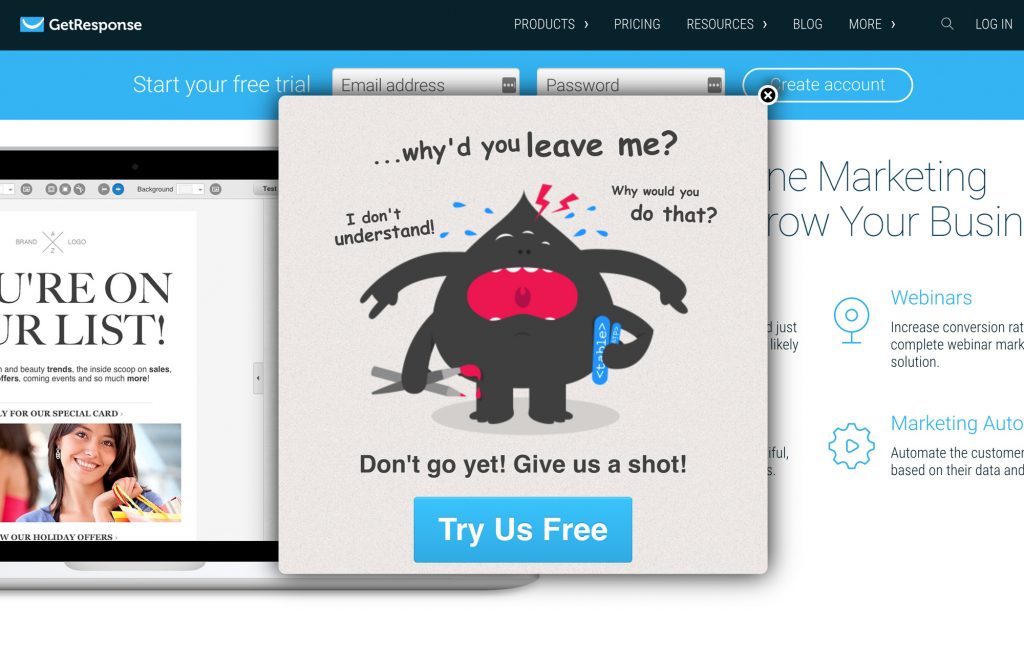
4. Let them try before they buy
Free trials and samples are the ultimate sales technique. It’s probably as old as selling itself. If you convince someone to try your product it’s like you’re almost at the finishing line. The thing has been successfully exercised by brands all over the world. For example, Zalando and its free returns offer, Muscat eyewear with the home try-ons, or most of the SaaS brands. (Speaking of which, you can try SentiOne for free for 7 days, you know.)
From the customer’s point of view, free trial limits the risk of purchase to almost zero. Depending on the trial functionalities, of course. It’s always better to leave some part a mystery so, as experts advice, try and lock some features to encourage upgrades.
Other than that, let the customer get used to your product and confirm they need you. Let them love you. Although, as you may foresee, this is a neuralgic spot for the customer lifecycle, as the marketing, product, sales, and customer support have to all pitch in to achieve the collaborative success. Your traffic, leads, and prospect mean nothing if the product is untenable or the help is worthless. Therefore, plan strategically and make sure you are all on the same page.
5. Proactively help using the product
Once your customer is trying out your product, you have to do your best for them to stay with you. This is the crucial part of the client’s decision-making process. If you are not helping and you don’t make it easy to get accustomed to your product, they will leave after those two weeks without a blink of an eye.
Effective onboarding should be based on four pillars:
- Client Success Team – proactive live support for setting up the account and the first stages of using the service,
- In-app tutorial – if you are a SaaS, you should pay a lot of attention to designing beautiful step-by-step help,
- Video tutorials and documentation (like on-site help centre) – make sure you provide all the self-service help in case your user wants to explore by himself,
- Onboarding emails – in their first days, try to be a good companion to your new user and share life-tested advice.
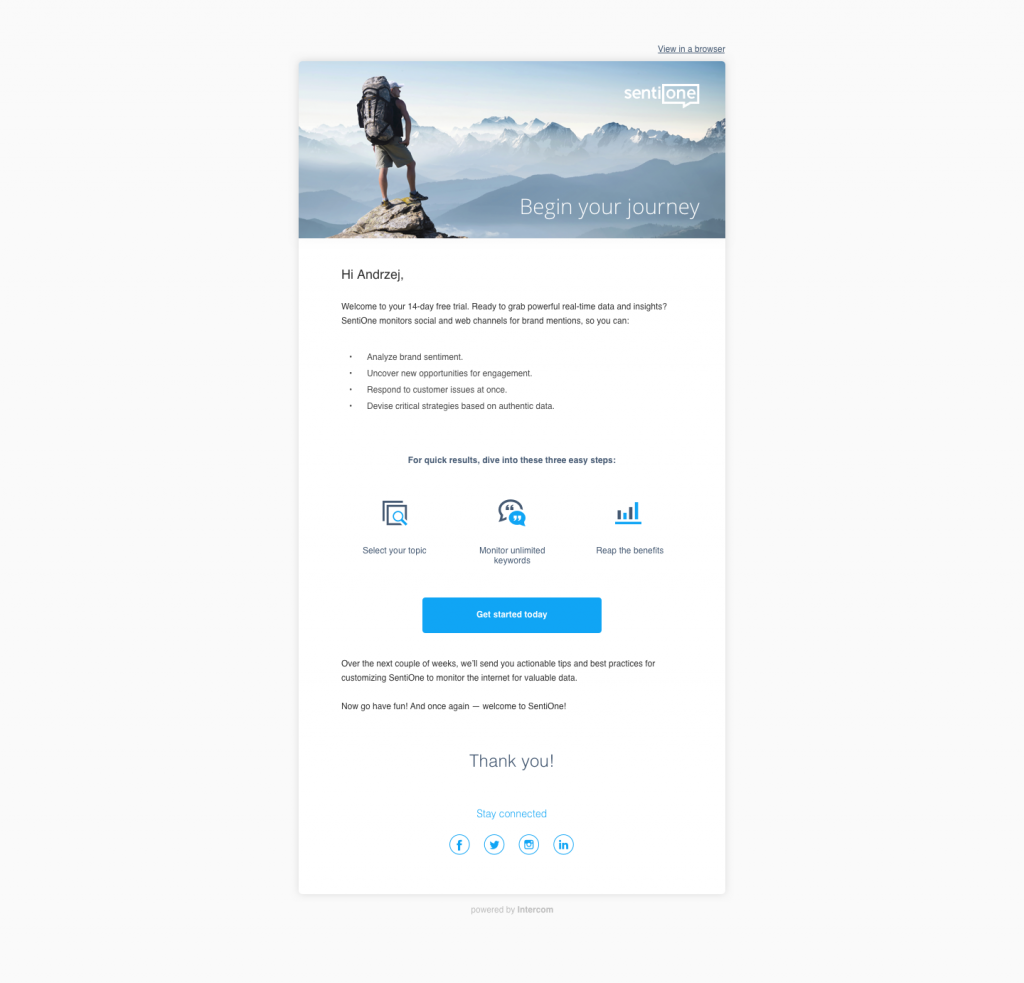
Magda Ciszewska says:
Human relations have been the main driver of business growth since… forever. We trust our friends, peers and business partners. A lot depends on how we get along. That’s why we strive to build relationships in every area of our life.
Salespeople travel across the world to meet their potential customers and pitch their solutions on face-to-face meetings. However, business is changing. The internet created almost infinite possibilities for establishing connections around the world. Even though in-person contact will always remain a crucial factor of success in sales, companies are now exploring online channels to find new business opportunities.
Social media has been traditionally treated as a perfect brand building tool with little consideration for its sales potential. Recent years challenged sales teams more and more with reaching out to their potential customers and prospects, so they went online. The stakes are high, the competition is tough, the need to stand out is needed now more than ever; but the audience – so much wider. Clever social and online engagement tactics can have a measurable impact on your business. It will simply make you money.
Social Selling
Good social selling strategy can occur as much more effective than the traditional sales approach. Salespeople don’t have to be limited to calling or emailing prospects. Social platforms like LinkedIn, Facebook, Twitter give them plenty of opportunities to find and engage with potential customers in one-on-one conversations.
You can get a tangible improvement of sales with the proper implementation of social selling. The 2016 LinkedIn, State of Social Selling research shows that most of successful sales specialists engage with their leads via social channels. Finding the right discussion on social media and taking part in it can get you a step closer towards closing a deal.
What can you do to create an effective social selling strategy?
- Create a strong company profile to attract leads
- Regularly publish relevant content and become industry expert
- Monitor and join online discussions in your industry
- Connect with professionals on LinkedIn
- Consider building a referral program.
Social selling might seem like it only works in B2C because of the direct approach people take on social media but the truth would surprise you. In fact, there are a lot of applications for social selling in B2B. The research on buyer behaviour conducted by International Data Corporation (IDC) finds out that 75% of B2B buyers and 84% of C-level level executives use social media to make purchasing decisions.
With social listening tools like SentiOne, your team can track web conversations surrounding your brand or industry and be the first to address them.
Social Proof
The concept of social proof isn’t new and it’s deeply embedded in the way people operate on a daily basis. Your potential customers seek confirmation before making decisions. They want to know that what they buy is socially accepted. So it’s crucial to ensure them that they have made a right choice. Marketers have been successfully using various techniques based on social proof for decades now:

Source: https://blog.kissmetrics.com/wp-content/uploads/2014/07/barry-image-1.jpg
Product reviews
Selling is not a one-way conversation anymore. Times where salespeople only presented their brands or products are definitely gone. Today we rely on what we hear or read about the product from other people. And mouth-to-mouth marketing has grown a lot in the era of social media. 70% of people say that they look at product reviews before making a purchase. That’s why platforms like toptenreviews.com, g2crowd.com which rely on reviews and ratings, have become so popular.
Although, people are more driven by vengeance caused by bad experience, ergo more likely to leave a negative review. Therefore, you need to ensure that you keep up with any issues to address them on time and help your customers solve potential crises. Listening platforms like sentione.com can help track all online mentions about your product, brand or industry and protect your image.
Testimonials and case studies
A satisfied customer is the best advocate for your brand. Leveraging the success of your customer builds trust. It simply shows that your product works and can inspire new prospects on how to benefit from choosing your brand.

Recognition
If you want to become a business shark, you need to act like one. People who come across your page not knowing anything about you or your product will naturally seek signs that they are dealing with a serious partner. Adding a customer count to your webpage or sharing names of recognisable brands that are using your product is a well-tested way to support your claims.

And don’t forget to share your awards and achievements. It gives you authority and helps to build trust in your expertise. Let me give you a real-life example. At SentiOne, we’ve actually noticed a pick in conversions after putting the banner below on our homepage.

To sum up, from my experience closing good deals is always based on relationships. If you make a good impression, seem professional and trustworthy, you can make it. Regardless the channel, your sales strategy should be focused on engaging the community and being there for your customers. Even if your revenue is based on enterprise sells, you should never underestimate the power of social media.
Chapter 5 Retention
Reducing churn rate by 5% can increase profitability between 25-125%.
[Source]
If you’ve read this guide so far, we would like to thank you very much for your time and attention. You are one of the most loyal readers, therefore you are precious to us. We believe that you’ve found some good advice along the way and hope that you will find some more of it further.
How does it feel to be appreciated as a loyal consumer? Probably as good as being praised for anything else – nice. And that is exactly how you may want your clients to feel.
Increase retention by 2% and you will have the exact same effect as you’d cut your costs by 10%. How so? Easy. Even though customers may join the lifecycle at different moments and their individual ways may differ, statistically, acquiring new clients is much more costly than keeping the ones that are already convinced.
That being said, believe it or not, most of the companies still focus a greater part of their efforts on growing new leads. Given that loyal customers are more likely to come back for more, your efforts should definitely be more balanced. Loyal customers are your greatest worth. They will recommend you to their friends, help you build awareness, and use your product for many billing periods to come. So whatever you do, remember this – a top-notch help desk and world-class support can do magic with your revenue.
1. Embrace your clients
Love them for whoever they are. And please remember not to lump them all together.
Try to segment your users and prepare personalised communication. They may have different needs depending on which features of your product they use, who the are, where they live, what they do for a living. Learn as much as you can and match your message to each separate person.
Obviously, no one expects you to write to them personally but there are pretty good email marketing tools out there that you may want to try. Start with creating nice templates and tagging your email base. That should do, for the beginning.
2. Reward loyalty
Showing your appreciation is something that you can’t overstate. In times when human attention span is shorter than this of a goldfish, a loyal client is worth his weight in gold.
How many times have you heard of a person leaving a mobile network company just because they have better offers for new-comers? What would make you let your contract die and go elsewhere? Never forget about those who have been with you for a long time, watched you improve and supported!
Choose one of the ways brands around the world keep their long-term relationships.
- Suggest a discount for yearly billing,
- Offer exclusive promotions,
- Give occasional gifts,
- Come up with repeat purchase discount,
- Propose loyalty club.
3. Track their preferences
Observe and learn. Test and improve. You might get fed up with it but we will keep saying this because agile approach goes a long way. You should keep up with your competitors, obviously. But most of all be ready to address your clients needs. Always meet them halfway.
Watch heatmaps but try asking for direct feedback as well. You can apply NPS score or any other satisfaction survey. Use a template or create your own questionnaire but bear in mind that this too works on your account. You can either show how easy-going you are by asking 2-3 simple questions taking no more than five minutes to answer at a time or kill everything with the most boring survey. Stay alert.
Also, each time let your clients know that their feedback is appreciated and they have an actual impact on your product. Communicate changes and thank them for support via emails or social media.
4. Be there for them
When asked, what makes them love your business, 73% of customers said it’s “friendly staff and great service” [source]. That’s almost three quarters. We may say that three out of four people would make their loyalty to your brand dependent on the support you are willing to provide.
To be honest, this makes sense. It’s one of those quid pro quo situations but it seems fair. The really curious part starts here – amongst most important traits of the perfect customer experience 14% of the survey respondents pointed to “Ability to interact 24/7 with the company via multiple channels”. And given that we drift off from traditional client service, that’s probably why you should equip yourself with the proper online CRM system.
Client support should now do more than just replying to complaints, they should proactively help users, be active and available on social media too. For example, with SentiOne you get both online listening and reputation management systems. You monitor your brand name or keywords regarding your industry and use SentiOne React tool to join social media discussions. Respond to each conversation directly from one tool.
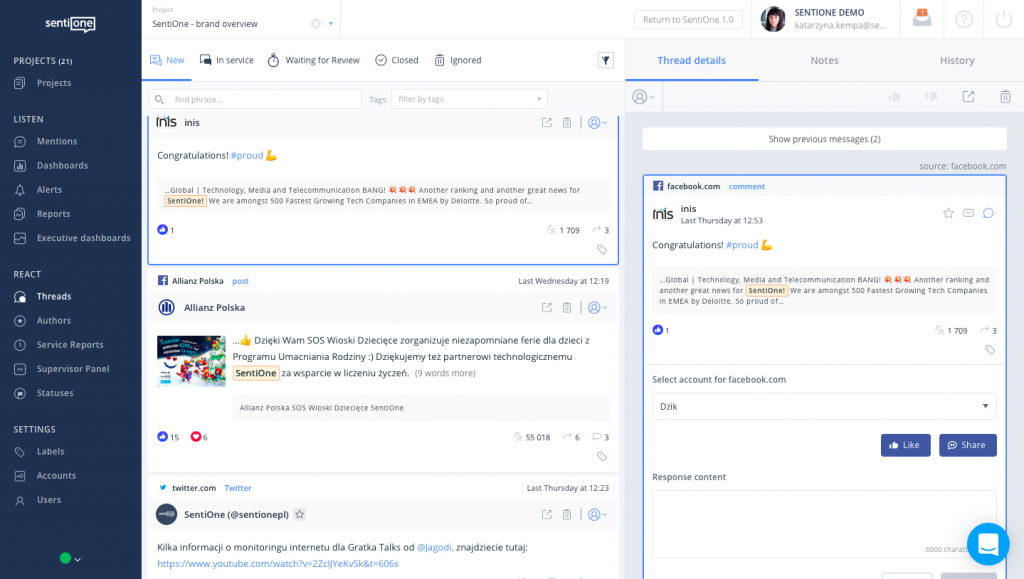
5. Show the backstage
And we’re back where we started. To showing your human face.
Now you can see that customer lifecycle truly is a cycle. And it goes around building relationships. For you need to gain your audience’s attention, engagement and trust to deserve loyalty and advocacy. And if you do, again, like most carbon-based lifeforms, be thankful and come a little closer.
Give your clients exclusive insight into how you make the magic happen. They will feel even more important, like you even more, which creates an extra special bond between your brand and the client. And make them more likely to recommend your brand to their friends, as in work for your brand awareness.

[Source]
Irek Klimczak says:
Retention should constantly be one of your top priority goals. First of all, selling to your existing customers is way cheaper than customer acquisition. According to the Pareto principle, 80% of your revenue is generated by 20% of your current customers, so clearly your customers have a huge impact on your business growth.
What’s more, selling to your existing customers is simply more profitable. That’s why you should do your best to increase CLV.
Secondly, loyal customers are a powerful lead generation channel since they are likely to recommend your brand among their friends (who are also likely to be your target audience). That’s why customer retention translates directly into more business.
As it comes to customer retention there are a few areas to focus.
Post-sell customer care
Marketers have been more and more focused on sales. And unfortunately, it often means that they’ve been focused heavily on the initial stages of the customer journey. But obviously, everything that happens after sales is equally (if not more) important.
You set up expectations, people trusted you with their money – now it’s time to delight them with exceptional customer care. Customer retention is a consequence of great customer service and customer experience.
Here’s what you can do after someone buys your product:
1. Say thank you and welcome them to the elite club of your customers.
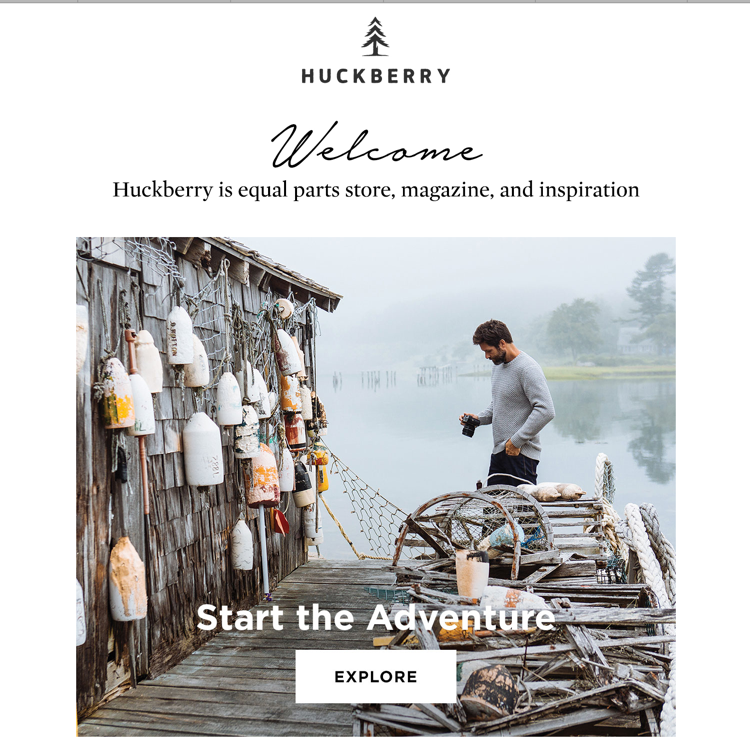
A fragment of a welcome email form Huckberry
2. Appreciate their business and make them feel a part of the community. Remind new customers about warranty, returns policy and anything they might use after purchase.
3. Remind them that your staff is available in case they need anything. You can also share case studies and customer testimonials in order to show them how to properly make use of your product.
Feedback
Another goal of the post-purchase communication is establishing a feedback loop. Your customers are a fantastic source of firsthand product information. They have a ton of valuable insights about your product or service. They can provide you with improvement ideas based on testing and experience and real-life use cases.
You can schedule emails asking for feedback in your post-purchase marketing cycle. This way you can stay pro-active without the need to remember when you’re supposed to send the email.
Incorporate the user-generated content into your content marketing strategy. This will help you increase engagement and consumer trust.
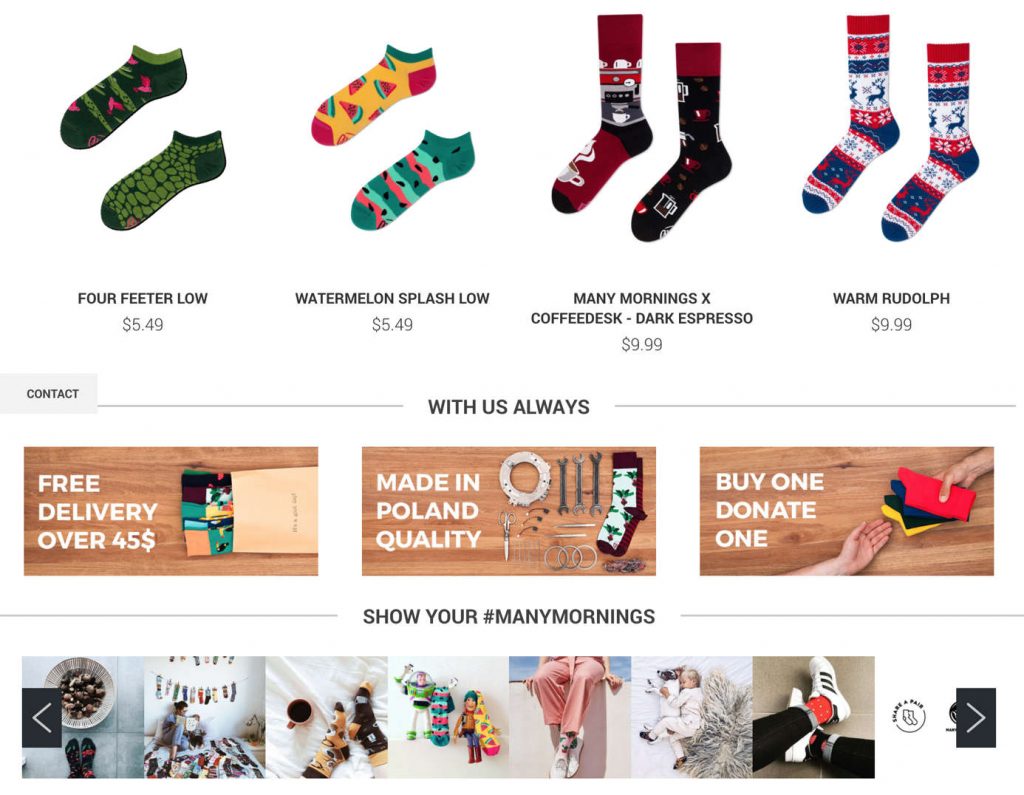
Many Mornings shows pictures made by users on their website
Loyalty
As far as email marketing is concerned, I always recommend offering something unique for subscribers, e.g. the latest information about the products, exclusive content and offers. People need to know the reasons for subscribing. Otherwise, why should they even bother?
Obviously, the same should relate to customers. If you want your customers to come back and repeat purchase, you need to provide an incentive. Prepare privileges for your customers, e.g. limited availability offers, first access to special events and promotions, so that they feel valued and don’t feel the need to check on your competition.
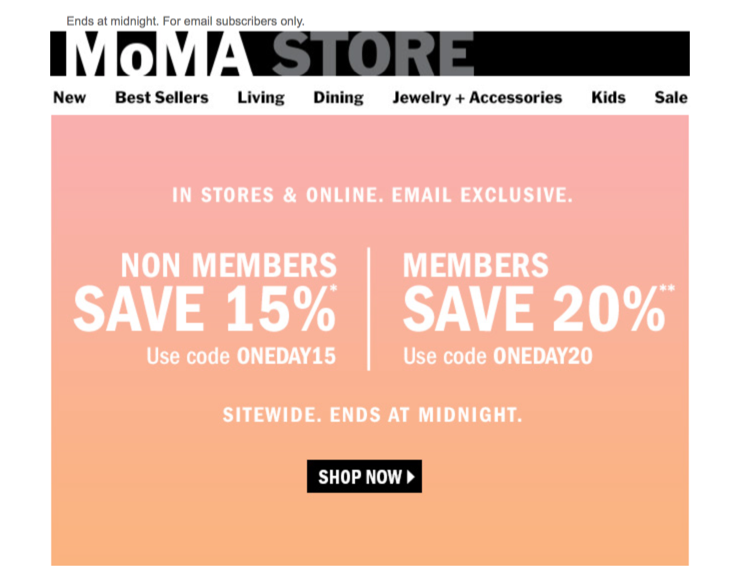
A fragment of an email exclusive offer where members save more
Upsell
I’ve already written that selling to your existing customers is way cheaper than acquiring new ones. There’s one more thing, satisfied customers also tend to buy more (I know, it’s great!).
It’s perfectly OK to suggest your customers buy more – however, on one condition – if the products or services you’re offering are relevant to their initial purchase.
Up-selling and cross-selling require relevancy. That’s exactly when a marketing automation platform comes in handy: you get to know your customers, segment your email list based on the collected information and send out personalized communication that increases the order value.
With the right tools, you can make up-selling and cross-selling truly effective parts of your revenue strategy.
Advocacy
Customer experience at each touch point along the customer journey translates into overall customer satisfaction. If you pay attention to details and offer great customer experience you delight your customers and turn them into your brand advocates.
They will certainly tell others how great it is to be your customer. I’m sure you can name at least a few brands you discovered through such recommendations.






